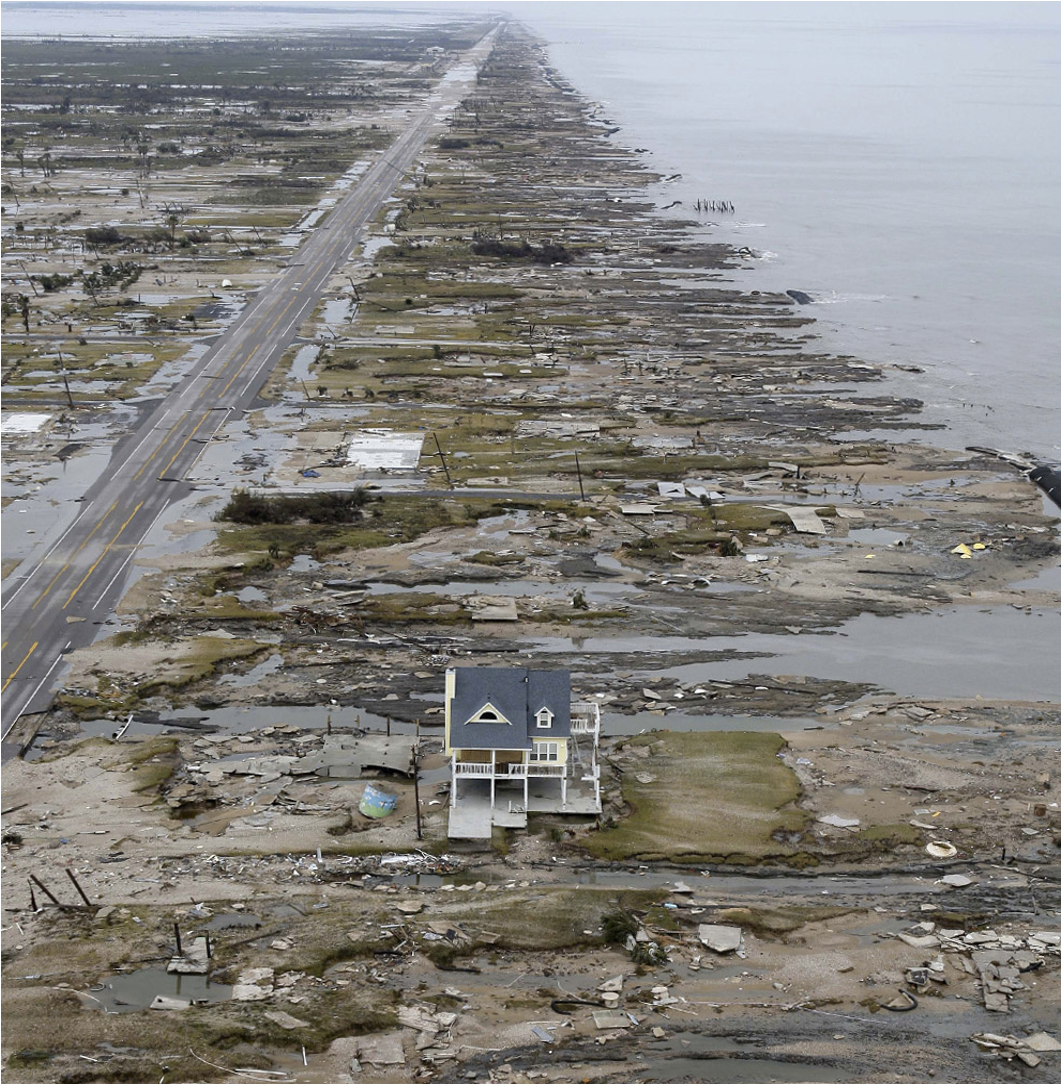The Ike Dike Project to Protect Texas Coasts
Responding to Rapid Climate and Land Use Change
William Merrell & Sam Brody
William Merrell
Professor and George P. Mitchell Chair
Department of Marine and Coastal Environmental Science
Texas A&M University at Galveston
Sam Brody
Professor, Department of Marine and Coastal Environmental Science
Texas A&M University at Galveston
Sponsored by PSW Science Members Brett Magaram & Robin Taylor and Larry Millstein
About the Lecture

Despite efforts to mitigate the adverse impacts of flooding across the United States (U.S.), losses from both acute and chronic events continue to rise, particularly in low-lying coastal areas. Increasing climate change risk combined with rapid land use change and development in flood-prone areas has amplified the adverse economic and human impacts in recent years. Adapting to climate-induced and human development changes has become a paramount issue for coastal cities in the U.S. While these cities continue to incur billions of dollars in flood losses every year, the U.S. flood mitigation system remains rooted in a recovery-based approach, which accepts failure to prevent flood damages and focuses on policies that encourage rapid building and recovery in flood-prone areas.
After Hurricane Ike in 2008 caused catastrophic impacts to the Houston-Galveston region of the Upper Texas Coast, flood risk reduction proposals have shifted to a more protection-based approach focusing on mitigating flood risk before an event takes place or eliminating it altogether. Input from researchers and practitioners in the U.S. and the Netherlands coalesced into a multidisciplinary proposal to protect one of the country’s most critical economic centers from future storm surge impacts called a Coastal Spine (aka, the “Ike Dike”). This presentation will trace the intellectual roots, research findings, and policy process of the Texas Coastal Spine for flood risk reduction, which is now the largest approved U.S. Army Corps of Engineers project in history. We will discuss the implications of adopting this protection-based, multifunctional approach as a pathway for more effectively protecting coastal communities in the face of exponentially increasing flood risk.
Selected Reading & Media References
Brody, S.D., +Lee, Y.J., Kothuis, B. (eds.). (2022). Coastal Flood Risk Reduction in the Netherlands and the U.S. Upper Texas Coast. Elsiver Press.
Brody, S.D., +Atoba, K., +Highfield,W., +Sebastian, A., +Blessing, R., +Mobley, W., +Stearns, L. (2021). A Comprehensive Framework for Coastal Flood Risk Reduction: Charting a Course Towards Resiliency. In Carolyn Kousky, Bill Fleming, and Alan Berger (eds.), Blueprint for Coastal Adaptation. Washington, DC: Island Press.
Davlasheridze, Meri, *Atoba, K.O., Brody, S.D., +Highfield, W.E., Merrell, W., Ebersole, B., Purdue, A., Gilmer, R. (2019). Economic Impacts of Storm Surge and the Cost-Benefit Analysis of a Coastal Spine as The Surge Mitigation Strategy in Houston-Galveston Area of Texas in the United States. Mitigation and Adaptation Strategies for Global Change 24: 329-354.
Atoba, Kayode, Brody, S.D., +Highfield, W.E., Merrell, W.J. (2018). Estimating Residential Property Loss Reduction from a Proposed Coastal Barrier System in the Houston-Galveston Region. Natural Hazards Review 19(3): 05018006.
About the Speaker

William J. Merrell
William J. Merrell is Regents Professor, President Emeritus and the George P. Mitchell Chair of Marine Sciences at Texas A&M University at Galveston. Previously Bill was President of the Heinz Center for Science, Economics and the Environment, and Vice Chancellor for Strategic Programs of The Texas A&M University System, Vice President for Research Policy of Texas A&M University. He also served as Chair of the Ocean Studies Board, on the Space Studies Board and on the Board on Sustainability of the National Research Council, and he has held Presidential Appointments with the National Science Foundation.
Bill’s scientific work has included studies of regional and large-scale ocean physics as well as coastal processes and hurricane impacts. Recently his interests have focused on coastal sustainability and disaster mitigation and recovery. Following the devastation of Hurricane Ike, he helped establish the Institute for a Disaster Resilient Texas, and he began the Ike Dike project to provide hurricane surge protection for the Upper Texas Coast including all of Houston and Galveston.
Among Bill’s honors and awards, he is the recipient of the Distinguished Achievement Medal from the Geosciences and Earth Resources Council, and he is the only person to receive the Distinguished Service Award of the National Science Foundation twice.
Bill earned a BS in Physics and an MA in Mathematics at Sam Houston State University and a PhD in oceanography at Texas A&M University.
Samuel D. Brody
Samuel D. Brody is Regents Professor and George P. Mitchell ’40 Chair in Sustainable Coasts in the Department of Marine and Coastal Environmental Science at Texas A&M University, Galveston Campus. He is also the Director of the Institute for a Disaster Resilient Texas, an Adjunct Professor in the Department of Civil and Environmental Engineering at Rice University, and a Senior Fellow at the Water Institute of the Gulf. He was also the Lead Technical Expert for the Governor’s Commission to Rebuild Texas in response to Hurricane Harvey.
Sam’s research focuses on coastal environmental planning, spatial analysis, flood mitigation, climate change policy, and natural hazards mitigation. He has published numerous scientific articles on flood risk and mitigation, and recently released the book, Coastal Flood Risk Reduction: The Netherlands and the U.S. Upper Texas Coast, published by Elsevier Press.
Sam teaches graduate courses in environmental planning, flood mitigation, and coastal resiliency. He has also worked in both the public and private sectors to help local communities adopt flood mitigation plans.
More information about Sam is available at www.tamug.edu/IDRT.
Minutes
On June 16, 2023, from the Powell Auditorium of the Cosmos Club in Washington, D.C, and by Zoom webinar broadcast on the PSW Science YouTube channel, Vice President Robert Thompson called the 2,479th meeting of the Society to order at 8:00 p.m. ET. He welcomed new members, and the recording secretary read the minutes of the previous meeting.
Vice President Thompson then introduced the two speakers for the evening, William J. Merrell, the Regents Professor, President Emeritus, and the George P. Mitchell Chair of Marine Sciences at Texas A&M University at Galveston, and Samuel D. Brody the Regents Professor and George P. Mitchell ’40 Chair in Sustainable Coasts in the Department of Marine and Coastal Environmental Science at Texas A&M University, Galveston Campus. Their lecture was titled, “The Ike Dike Project to Protect Texas Coasts.”
Merrell began by explaining that the long title for the talk was “Protecting America’s Coasts from Flooding in the Face of Rapid Climate and Land Use Change.” The speaker then reviewed expectations on population growth, and the implications of population to pollution and potential for human adaptation to a changing climate. The speaker then reviewed two reasons why adaptation is especially important at the coasts. Firstly, the speaker explained, the US is still building and moving to the coasts and in the past increasing coastal storm losses have correlated well with the increasing population and related infrastructure. The second reason regarded coastal vulnerabilities including to infrastructure and threats.
Merrell then argued the next century will be an era of coastal adaptation and reviewed the approach he and Brody have taken to make this argument.
Brody then began by thanking President Millstein and the society for the invitation to speak. Brody continued by emphasizing that there is an ongoing crisis due to mega events that cost billions of dollars. The speaker emphasized this point by reviewing a map of flood insurance claims.
The speaker mentioned the current recovery-based approach to management. The mitigation and preparedness of floods revolves around insurance, an outdated 100-year floodplain model, and a method of chasing the last great storm. As an example, the speaker reviewed the coastal storm protection projects implemented at the federal level in the Houston-Galveston Region. He began the example by reviewing a map of the physical flood risk and comparing this with estimates of land use and sea level rise. The human built environment, the speaker argued, is a main driver of flood risk and causes urban flooding. Urban flooding is increased by inadequate drainage infrastructure, development that places obstacles to streams, and development that does not recognize natural drainage patterns.
The speaker then argued for a protection-based approach to management, such that flood losses are eliminated as opposed to adapting to the loses. To successfully implement this approach, the solutions need to be regional and implementation local. The speaker called this the coastal spine strategy, which aims to keep the ocean surge out of Galveston Bay by using a gated coastal barrier. The media, Brody explained, dubbed this the Ike Dike. The components of the Ike Dike are the Galveston Seawall, land extensions, and flood gates. The speaker then reviewed flood maps before and after the implementation of the Ike Dike to demonstrate its usefulness.
Brody then discussed a book written by the speakers called Coastal Flood Risk Reduction, which summarized the previous decade of the research performed. The speaker went on to discuss the policy implications for future flood resistance. He highlighted the need to consider life cycles of projects, cumulative impacts of developments, and protection-based approaches with emphasis on adaptation. The need for better communication of flood risk was also emphasized.
Merrell then reviewed specifics to the policy implication. The speaker argued the scientific challenges have been mostly solved, and that the policy difficulties remain a challenge. The speaker reviewed the next steps for Ike Dike. First, Congress has authorized but not yet appropriated $34.4 billion for the construction of the project after determining it is in the national interest. Additionally, the design must be finalized, operational costs must be allocated, and the project must be completed prior to a destructive event to the region.
Next the question-and-answer period began. First, a member asked about the implications to the DC region, specifically the Chesapeake Bay, Potomac River, and Anacostia. Merrell answered by reviewing the water levels. The sea level rise in the DC region is expected to be 12 inches by 2050. The Chesapeake Bay is already showing signs of increasing water levels and the Potomac is showing signs of tidal flooding problems. Major rainfall is expected in the region and will cause urban flooding because of the inability of the existing infrastructure to handle the runoff. Another member asked from online whether AI tools have been applied to the data sets used for predictive models. Brody enthusiastically responded with yes. Machine learning has been used to learn where development will occur in the future, which enables scientists to identify where people will build and what risk will emerge as a result.
After the question-and-answer period, Vice President Thompson thanked the speakers, made the usual housekeeping announcements, and invited guests to join the Society. Vice President Thompson adjourned the meeting at 9:56 pm.
Temperature in Washington, D.C.: 18° C
Weather: Clear
Attendance in person in the Powell Auditorium: 26
Number of streaming online viewers: 26
For a total in-person attendance of 52
Views during the 2-week period after the lecture: 277
Respectfully submitted,
Erica Kane on behalf of the Recording Secretary